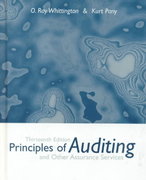Select the best answer for each of the following and explain the reason for your selection. a.
Question:
Select the best answer for each of the following and explain the reason for your selection.
a. Which of the following procedures is least likely to be completed before the balance sheet date?
(1) Confirmation of receivables.
(2) Search for unrecorded liabilities.
(3) Observation of inventory.
(4) Review of internal accounting control over cash disbursements.
b. An audit of the balance in the accounts payable account is ordinarily not designed to:
(1) Detect accounts payable that are substantially past due.
(2) Verify that accounts payable were properly authorized.
(3) Ascertain the reasonableness of recorded liabilities.
(4) Determine that all existing liabilities at the balance sheet date have been recorded.
c. Which of the following is the best audit procedure for determining the existence of unrecorded liabilities?
(1) Examine confirmation requests returned by creditors whose accounts appear on a subsidiary trial balance of accounts payable.
(2) Examine unusual relationships between monthly accounts payable balances and recorded purchases.
(3) Examine a sample of invoices a few days prior to and subsequent to year-end to ascertain whether they have been properly recorded.
(4) Examine selected cash disbursements in the period subsequent to year-end.
d. Auditor confirmation of accounts payable balances at the balance sheet date may be unnecessary because:
(1) This is a duplication of cutoff tests.
(2) Accounts payable balances at the balance sheet date may not be paid before the audit is completed.
(3) Correspondence with the audit client's attorney will reveal all legal action by vendors for nonpayment.
(4) There is likely to be other reliable external evidence available to support the balances.
e. A client erroneously recorded a large purchase twice. Which of the following internal control measures would be most likely to detect this error in a timely and efficient manner?
(1) Footing the purchases journal.
(2) Reconciling vendors' monthly statements with subsidiary payable ledger accounts.
(3) Tracing totals from the purchases journal to the ledger accounts.
(4) Sending written quarterly confirmation to all vendors.
f. For effective internal control, the accounts payable department should compare the information on each vendor's invoice with the (1) Receiving report and the purchase order.
(2) Receiving report and the voucher.
(3) Vendor's packing slip and the purchase order.
(4) Vendor's packing slip and the voucher.
Step by Step Answer:

Principles Of Auditing And Other Assurance Services
ISBN: 9780072327267
13th Edition
Authors: Ray Whittington, Kurt Pany





